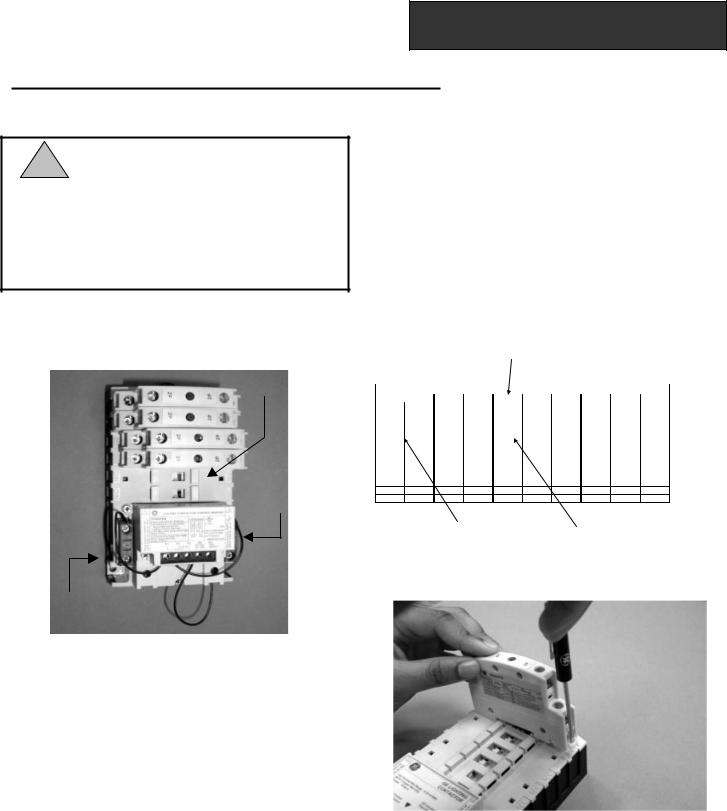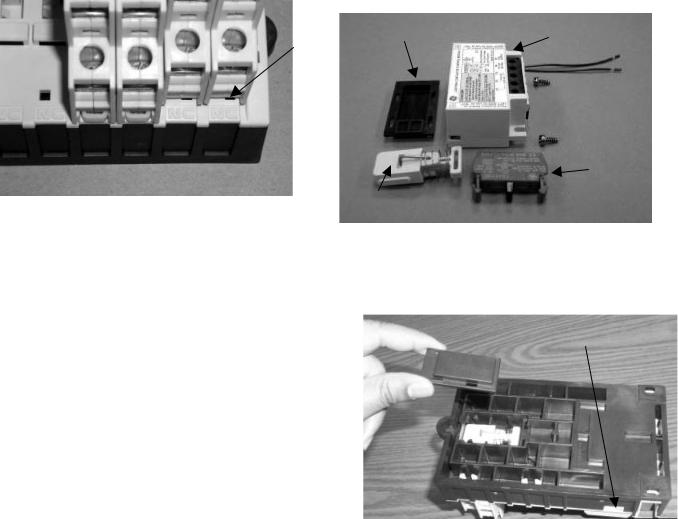GE Industrial Solutions CR460 LIGHTING CONTACTOR SERIES User Manual

g
DEH-40460 Instruction Sheet
GE Lighting Contactors
CR460 LIGHTING CONTACTOR SERIES
!WARNING !
HAZARDOUS VOLTAGE
Disconnect all power before working on equipment.
Electrical shock will cause severe injury or death.
TENSION DANGEREUSE
Coupez l’alimentation avant travailler sur le produit.
Electrocution peut causer de severes blessures ou la mort.
Description
The GE CR460 Series is a magnetically operated lighting contactor, and is available in either an open or an enclosed form. These contactors are field configurable for up to twelve poles, with a maximum of eight normally closed “NC” poles.
Main Base
NC Aux.
Contact
NO Aux.
Contact
Figure – 1 Mechanically Held Contactor
1 MAIN BASE
1.1 Description
The base of the lighting contactor (see Figure 1) has provisions to accept power poles at positions “1” to “6”. Provisions are also provided for up to 2 “NO” and 2 “NC” auxiliary contacts.
1.2 Installation
1.Remove all packing material from the base and all the kits.
2.Contactor must be mounted in the vertical position on a sturdy support.
3.Additional over-current protection may be required. Refer to the National Electrical Code or local electrical code as required.
4.Refer to Table D on page 3 for the wire size and the required torque for the coil terminals.
2 POWER POLES: CR460XP31 / 32
2.1 Description
Power poles are available in both single pole (CR460XP31) and double pole (CR460XP32) versions. A maximum of twelve poles may be installed on the base. Positions “1” to “4” on the base can be configured as either normally open “NO” or “NC” while positions “5” and “6” can be configured as “NO” only.
2.2 Removal and Conversion of Power Poles
1.If installed ensure that all power is disconnected.
2.For multiple possible configurations of the power pole, refer to the Table A below.
#of NC Contacts desired (3)
NO |
|
|
|
|
NC |
|
|
|
|
|
0 |
1 |
2 |
3 |
4 |
5 |
6 |
7 |
8 |
||
|
||||||||||
0 |
|
|
20 |
30 |
40 |
50 |
60 |
70 |
80 |
|
1 |
|
11 |
30 |
31 |
50 |
51 |
70 |
71 |
90 |
|
2 |
20 |
30 |
40 |
50 |
60 |
70 |
80 |
90 |
B0 |
|
3 |
30 |
31 |
50 |
51 |
70 |
71 |
90 |
91 |
CO |
|
4 |
40 |
50 |
60 |
70 |
80 |
90 |
B0 |
C0 |
D0 |
|
5 |
50 |
51 |
70 |
71 |
90 |
91 |
C0 |
|
|
|
6 |
60 |
70 |
80 |
90 |
B0 |
C0 |
D0 |
|
|
|
7 |
70 |
71 |
90 |
91 |
CO |
|
|
|
|
|
8 |
80 |
90 |
B0 |
CO |
D0 |
|
|
|
|
|
9 |
90 |
91 |
CO |
|
|
|
|
|
|
|
10 |
B0 |
CO |
DO |
|
|
|
|
|
|
11C0
12D0
# of NO Contacts desired (4) |
Standard Catalog # Digits |
|
CR463L70AJA0 |
Table A
3.Remove block by pulling the clip as shown (see Figure 2). Rotate block 180 degrees to convert from NO to NC.
Figure – 2
2.3 Installation of Power Poles
1.Check moving carrier to assure free movement
2.Install the block by sliding foot into slot; pull the clip, and position block onto base. Release the clip.

3.Check for the lettering on the base. “NO” should be visible if the power pole is assembled as normally open, or “NC”, if it is assembled a normally closed (see Figure 3).
Figure – 3
2.4 Termination
Power poles can accept wires from #14 to #8 AWG (either solid or stranded) as single or combination of two wires (refer to Table B below for valid wire combination). Refer to Table D on page 3 for the required torque.
Size |
Type |
8 AWG |
10AWG |
12AWG |
14AWG |
|||||
Stranded |
Stranded |
Solid |
Stranded |
Solid |
Stranded |
Solid |
||||
|
|
|
||||||||
8 AWG |
Stranded |
X |
X |
X |
X |
X |
X |
X |
||
10AWG |
|
Stranded |
|
X |
X |
X |
X |
X |
X |
|
|
Solid |
|
|
X |
X |
X |
X |
X |
||
|
|
|
|
|||||||
12AWG |
|
Stranded |
|
|
|
X |
X |
X |
X |
|
|
Solid |
|
|
|
|
X |
X |
X |
||
|
|
|
|
|
|
|||||
14AWG |
Stranded |
|
|
|
|
|
X |
X |
||
Solid |
|
|
|
|
|
|
X |
|||
|
|
|
|
|
|
|
|
|||
|
|
|
|
Table B |
|
|
|
|
||
3 |
|
AUXILIARY CONTACTS: CR460XB1/XB2 |
|
|||||||
3.1 |
Description |
|
|
|
|
|
|
|||
The auxiliary contact blocks are available in both single pole (CR460XB1) and double pole (CR460XB2) versions. Auxiliary contacts can be added on either side of the base (see Figure 1). When added to the LEFT side of base, the auxiliary block functions as “NO”, and when added to the RIGHT side of base it functions as “NC”. Refer to Table D on page 3 for wire size and required torque.
4 CONTROL MODULE KITS
The base (electrically held) can be converted to a mechanically held type by adding the control module kit.
IMPORTANT: The control module kits are for use with the coils up to 277 Vac maximum. Use a control power transformer for higher voltages.
Conversion from an electrically held to a mechanically held type is possible by adding the “control module kit” to the base.
4.1 Description
Control modules kits are available both for 2-wire and 3-wire control with a wide range of control voltage inputs. Figure 4
shows the components in 2-wire control module kit. A 3-wire kit includes an additional single-pole auxiliary contact block. Refer to the Ordering Detail section for more information on the control module kits and the control voltages available.
Latch Cover |
Electrical |
|
|
|
Module |
Aux. Contact
Latch
Figure – 4
4.2 Installation
1.Disconnect all power and mount the control module on the contactor as shown in Figure 1 (3-wire control type).
2.Mount the latch and the latch cover as shown in Figure 5.
Operation tab
Figure – 5
3.Be sure the latch is firmly in place with the wire facing out and the slot positioned with tab inserted.
4.Operate contactor manually, using manual operation tabs on side, prior to installing cover to insure correct installation.
Note: Once latch cover has been installed, it may not be removed.
5.For 2-wire control, the auxiliary contact block is assembled to the right side of the base for “NC”.
IMPORTANT: Latch and electronic module must be used together to ensure proper operation. Failure to do so will void warranty.
4.3 Wiring
Follow the schematic (Figure 6) for 2 and 3-wire control. Refer to Table D on page 3 for wire size and required torque.
Note: For 2-wire control, ensure the two wires coming from the control module are connected across a NC auxiliary contact.
2
